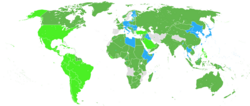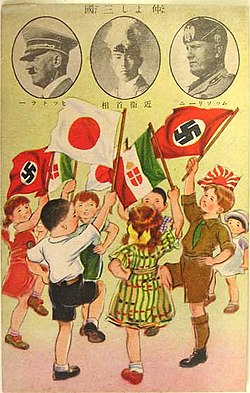Axis
 From Rationalwiki
From Rationalwiki 
| Suppress the dissenters Fascism |
| Bundle of rods |
|
| Fascists |
|
| Groups |
v - t - e
|
The Axis was a military alliance of far-right dictatorships, which were aligned against the Allied Powers (Great Britain, United States, Soviet Union, Republic of China, and others) during World War II. The alliance grew out of the diplomatic rapprochement between Germany and Italy, with the purpose of securing their military interests. Those two nations would sign a cooperation treaty in October 1936, an event followed shortly by a speech by Italian leader Benito Mussolini proclaiming that they had created a "Rome-Berlin Axis."[1] Less than a month later, Germany and Japan signed the Anti-Comintern Pact, directed at the Soviets. Italy joined shortly thereafter. Military provisions of the alliance were established and formalized in the Pact of Steel on May 22nd, 1939. Finally, the three powers would sign the Tripartite Pact on September 27th, 1940, which would become known as the Axis Alliance.
Their stated goal was to oppose both internationalist capitalist powers (the Allies) and communism (the Comintern).[2] Axis countries generally preferred an authoritarian "state capitalism" which somewhat resembled mercantilism under absolute monarchists. However, the primary practical purpose of the alliance was to overthrow the post-WWI global order and establish new empires through military conquest.[3]
Nations of the Axis[edit]
Major Axis powers[edit]
The three main powers in the Axis were:
- Germany (having annexed Austria and the Sudetenland) under the Nazi rule of Adolf Hitler
- Italy (having annexed Albania) under the fascist rule of Benito Mussolini
- Japan (having annexed Manchuria) under a military dictatorship (Emperor Hirohito was nominally the leader but more of a figurehead during WWII, at least until the very end)
Minor Axis powers[edit]
In addition to the three original signatories to the Tripartite Pact, there were a number of other members in the Axis, which included both independent states and puppet governments. They were:
- Croatia, under the rule of Ante Pavelić and the Ustaše (close allies of Fascist Italy) between 1941 and 1945 (the rest of Yugoslavia was invaded and divided among Germany, Italy, and Bulgaria.)
- Slovakia, under the rule of Jozef Tiso and the Slovak People's Party between 1939 and 1945.
- Hungary under the monarchist[4] rule of Miklos Horthy, who served as regent in the absence of a Hapsburg.
- Hungary again under the genocidal Arrow Cross regime of Ferenc Szálasi that Hitler installed in 1944 after losing his faith in Horthy.
- Romania under the authoritarian nationalist dictatorship of Ion Antonescu.
- Bulgaria under Tsar Boris III.
- Thailand under Plaek Phibunsongkhram.
- And several puppet governments set up by Germany, Italy, and Japan in occupied countries such as Manchuria and Norway.
Axis co-belligerents[edit]
There were also nations which fought alongside the Axis against common enemies. These nations did not sign the Tripartite Pact and should not be considered part of the Axis.
- Some sources list Finland as an Axis country. This is because Finland was at war with the Soviet Union at the same time as Nazi Germany and the two countries cooperated in military activity against the USSR including jointly invading in Operation Barbarossa. However, after the USSR withdrew from Finland to concentrate on driving Nazi forces out of their country, Finland turned against the Nazis and fought to drive German troops out of their country in 1945;[5] as such, they are best described as having merely been cobelligerent with the Axis for a time.
- The Kingdom of Iraq briefly fought against the Allies after attempting to expel the British from their country. Hitler planned a joint offensive in the Middle East, but Iraqi forces collapsed before this could become a reality.[6]
Nations with disputable neutrality[edit]

Several nations, while remaining officially neutral, cooperated with or had friendly relations with one or more Axis alliance members.
- Vichy France between 1940 and 1944 was neutral in name only. In reality, it collaborated extensively with the Nazis and other Axis powers. After Phillipe Pétain capitulated to Hitler's demands and handed over half of France, including Paris, to be occupied by Germany, he was allowed to rule the south of France where he set up a fascist-lite regime from the new capital in Vichy. Pétain readily gave France's Indochina colonies to Japan when asked.[7] France's colonies in north Africa under Vichy control were the early target of Operation Torch in 1942 and 1943, the Allied effort to open a front against the Axis in Africa. In defiance of Allied expectations, French forces stubbornly resisted.[8] The western allied powers finally invaded France directly in June of 1944 and overthrew the Vichy regime along their way to Germany. France later sought the return of French Indochina following the defeat of Japan but the Viet Minh refused to be recolonised. This would lead to some problems further down the line. The Vichy regime was also heavily complicit in the Holocaust, deporting tens of thousands of Jews into German concentration camps, where 77,000 would perish.[9]
- Portugal under António de Oliveira Salazar was not a member of the Axis despite having a far-right nationalist dictatorship. Salazar honored Portugal's longstanding alliance with the British and was the only European leader to predict that Hitler would lose the war. In 1940, Salazar allowed for some 2,000 evacuees from Gibraltar to temporarily settle in Madeira and later granted the Allies basing rights in the Azores.[10] Portugal drifted further into the Allied camp after the Japanese invasion and occupation of Portuguese Timor. However, he still maintained trade relations with the Axis.
- The dictator of Spain, Francisco Franco, on the other hand, actively identified his regime with the Axis powers. Franco's regime signed the Anti-Comintern Pact in March of 1939, becoming its fourth member alongside Germany, Italy and Japan. While Franco never signed the Tripartite Pact, he actively aided the German war effort in the East, sending nearly 47,000 Spaniards to fight on the Eastern Front as "volunteers."[10] Contrary to popular belief, the vast majority of those who served in the Blue Division were drawn from the regular Spanish Army; less than a third were civilian Falangists. Unlike Portugal who was officially neutral, Spain was "non-belligerent," much as Italy had been before the Battle of France. However, Franco also refused to let Hitler march through Spain to Gibraltar, and at one point made defensive preparations against a possible attempt to do so. Franco's Axis leanings eventually became vital to Allied strategy. In an operation code-named 'Mincemeat,' the British dumped a corpse carrying falsified war plans off the Spanish coast, knowing the Spaniards would quickly pass it to the Germans.[11] This duped Hitler into expecting an Allied invasion of Corsica and Sardinia, when the actual invasion landed in Sicily.
Post-War, Portugal became a member of NATO and the UN, while Spain wasn't part of either until 1956 and 1982, respectively. This was likely because Franco, unlike Salazar, had favored the Axis over the Allies during the war. Both men remained in power until the 1970's.
Goals of the Axis alliance[edit]

As a military alliance, the Axis functioned as a primarily offensive apparatus; the partnerships between its three main members were intended to enable them to fulfill their military ambitions. Of the three, Germany has had its motives most closely examined. Hitler spent much of the late 1930s reversing the Treaty of Versailles' limitations on German power by annexing Austria and Bohemia-Moravia, and dramatically increasing Germany's military capacity.[12] This reached a climax when Hitler forced a variety of symbolic humiliations on the French following their capitulation.[13] After the fall of France, Hitler's primary goal became the destruction of Soviet communism and the annexation of lands to the east in order to provide lebensraum for the German people.[14] This expansionism was considered vital due to Germany's expanding population; it had to import most of its food, which became a problem during the British blockade in WWI.[15] However, the most infamous motivating factor behind Hitler's wars were the racial policies of the Nazi Party, which emphasized Aryan racial superiority and mandated the extermination of Jews and other undesirables across East and Central Europe.
Benito Mussolini saw the Axis as a path to geopolitical dominance for Italy. After witnessing the hostile yet impotent response from the Western Allies after his invasion of Ethiopia, Mussolini decided they were decaying empires, not worth his time. Cooperating over the Spanish Civil War brought him closer to Hitler's Germany. Italy's goals for expansion consequently shifted.[16] He sought the return of Italian territories sacrificed during the Risorgimento (Nice and Savoie), as well as the conquest of British and French colonies in Africa. This territorial expansion, Mussolini reasoned, would lead to Italian domination of the Mediterranean and the birth of an era of Italian greatness not seen since the Roman Empire.[17] He was a bit too daffy to make it happen.
Japan, which had spent the last decades growing increasingly militaristic and aggressive, was already deeply involved in an invasion of China by the time the war began. Dutch colonies in Asia were rich in oil reserves, which Japan desperately needed to supply its war effort. British and French holdings also had vital resources. It sought to create a Japanese-dominated alliance called the East Asian Co-Prosperity Sphere,[18] where all the Asian people were equal, but the Japanese were a whole lot more equal that everybody else. Japan's imperial ambitions placed it into direct conflict with the old empires of Britain and France, and the rising United States. The last part went poorly for them.
Recent usage (or perhaps, misuse)[edit]
George W. Bush attempted to revive the Axis term, in the context of a modern "Axis of Evil," to refer to something other than the Nazi/fascist dictatorships of WWII and to drum up support for war in the Middle East in a Godwin's Law style. This usage is probably on the same level as the neologism "Islamofascism." In other words, bullshit rooted in using moral equivalence as a propaganda tactic. Doctor Evil reportedly rejected the idea, on the grounds that "They're not quite evil enough. They're semi-evil. They're the Diet Coke of evil, just one calorie, not evil enough."
External links[edit]
- The Axis of Just as Evil
References[edit]
- ↑ Why We Call the Axis Powers the 'Axis Powers' by Jason Daley. Smithsonian.com 2016 Nov 1
- ↑ Stanley G. Payne. A History of Fascism, 1914–1945. Madison, Wisconsin, USA: University of Wisconsin Press, 1995. P. 379
- ↑ The Axis Alliance US Holocaust Memorial Museum.
- ↑ The Horthy Era (1920-1944) Sean Lambert The Orange Files: Notes on Illiberal Democracy in Hungary Feb. 2017
- ↑ Finland Declares War on Germany History Channel.
- ↑ Lyman, Robert (2006). Iraq 1941: The Battles for Basra, Habbaniya, Fallujah and Baghdad. Campaign. Oxford: Osprey. ISBN 1-84176-991-6.
- ↑ French Indochina in WWII C. Peter Chen, WWII Database.
- ↑ Operation Torch C N Trueman "Operation Torch" The History Learning Site, 19 May 2015.
- ↑ Holocaust Encyclopedia: France US Holocaust Memorial Museum.
- ↑ 10.0 10.1 Portugal in WWII C. Peter Chen, WWII Database.
- ↑ Operation Mincemeat Ben Macintyre, BBC History.
- ↑ Breaking the Versailles Treaty Secondworldwar.co.uk, January 15th, 2016
- ↑ Hitler's Greatest Revenge "Hitler's Greatest Revenge" National Geographic 11th Nov. 2015
- ↑ Invasion of the Soviet Union US Holocaust Memorial Museum.
- ↑ Food and Nutrition (Germany) "Food and Nutrition (Germany)," International Encyclopedia of the First World War.
- ↑ What were the Goals of the Axis Powers and Soviet Union during World War Two
- ↑ Mussolini's Roman Empire "Mussolini's Roman Empire," New York Times June 20, 1973.
- ↑ Greater East Asia Co-Prosperity Sphere
Categories: [War] [Fascism] [History]
↧ Download as ZWI file | Last modified: 11/08/2025 11:50:49 | 62 views
☰ Source: https://rationalwiki.org/wiki/Axis | License: CC BY-SA 3.0
 KSF
KSF